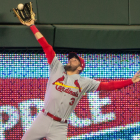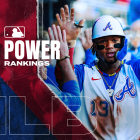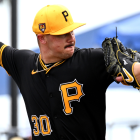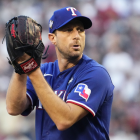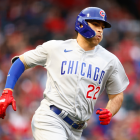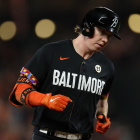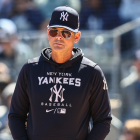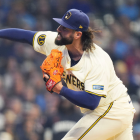
The arrival of the offseason means that it's time to rank stuff. Already this winter, we've sized up the 60 best free agents, both on an overall and positional basis. There's no law that prevents us from ranking minor-league players in addition to their big-league counterparts. As such, we're going to spend the winter evaluating every team's farm system.
The lack of a minor-league season makes that more of a challenge this year. It doesn't help that some teams opted against sharing video and data from their alternate-site camps with the rest of the league. As such, we've opted against overthinking this. Our rankings will essentially be the same as they were last winter with a few changes. First, we'll exclude anyone who graduated by exhausting their rookie eligibility; second, we'll replace them with draftees or other worthy prospects; and third, and lastly, we'll present the information in a new format.
In every article in this series, you'll find a team's top five prospects as well as five others we felt like including, either because of their promise or some other reason. For those top five prospects, you'll find a quick summation of their pros (their saving grace, if one will) and their cons (their fault line), as well as beefier report and our attempt to peg their "likeliest outcome."
These rankings were compiled by talking to industry folks -- scouts, analysts, and other evaluators -- and include a touch of our own evaluative biases. Remember, that this is more of an art than a science, and that the write-ups matter more than the rankings themselves.
Now, let's get on to the top five prospects in the St. Louis Cardinals system.
1. Dylan Carlson, OF
Age (as of 4/1/2021): 22
Height/Weight: 6-foot-2, 205 pounds
Acquired: No. 33 pick in the 2016 draft (Elk Grove High School, Florida)
Highest level: MLB
Saving grace: Offensive potential
Fault line: Secondary value
Scouting report: The switch-hitting Carlson appeared in 35 big-league games, batting just .200/.252/.364 with a 29.4 percent strikeout rate. There's ample reason to think he'll put that disappointing stretch behind him sooner than later, beginning with his relative youth and his well-rounded offensive skill set. Carlson has a disciplined approach; ample bat speed; and above-average raw strength. There's a chance he trades some contact for power; otherwise, he should be able to contribute to each of the triple-slash line stats. The Cardinals used him a fair amount in center field in 2020, but he might outgrow that as he ages. Carlson is also regarded as a hardworker who's a good bet to max out his physical skills.
Likeliest outcome: Middle-of-the-order hitter
2. Nolan Gorman, 3B
Age (as of 4/1/2021): 20
Height/Weight: 6-foot-1, 210 pounds
Acquired: No. 19 pick in the 2018 draft (Sandra Day O'Connor High School, Arizona)
Highest level: High-A
Saving grace: Above-average power
Fault line: Strikeout tendencies
Scouting report: Gorman's profile can be summed up easily: boom or bust. He has loud, loud raw power and loud, loud swing-and-miss issues. In 2019, he punched out in roughly 30 percent of his plate appearances split between two levels, all the while posting an ISO north of .190. Gorman isn't going to contribute a ton of value on the defensive side of things, meaning everything will boil down to whether he makes enough contact to be productive. His age and track record suggests he will, but it's too early to say for certain.
Likeliest outcome: Streaky third baseman
3. Matthew Liberatore, LHP
Age (as of 4/1/2021): 21
Height/Weight: 6-foot-4, 200 pounds
Acquired: Part of the Randy Arozarena trade (Rays)
Highest level: A-ball
Saving grace: Curveball
Fault line: Strikeout profile
Scouting report: The key to the Randy Arozerana trade, so far as the Cardinals are concerned, Liberatore has a chance to become an above-average starter thanks to his above-average sinker and well-above-average curveball. He's likely to be more of a contact manager more so than a strikeout artist once he reaches the majors. That's okay; the Cardinals seem to be one of the few organizations who are still on board with sinkerballer types. Liberatore generated nearly 60 percent grounders against A-ball competition in 2019, which bodes well for his future.
Likeliest outcome: Mid-rotation starter
4. Zack Thompson, LHP
Age (as of 4/1/2021): 23
Height/Weight: 6-foot-2, 215 pounds
Acquired: No. 19 pick in the 2019 draft (Kentucky)
Highest level: High-A
Saving grace: Polished left-hander
Fault line: Injury risk
Scouting report: The Cardinals have a history of opportunistic drafting, specifically as it pertains to collegiate pitchers. Thompson has a chance to be the next example of that phenomena -- provided he can stay healthy. He could feature four average or better pitches at maturation, including a high-grade curveball. Alas, Thompson has never thrown more than 90 innings in a season, even dating back to his days at Kentucky. The Cardinals used him primarily as a reliever after picking him in 2019. Rest assured, his ideal future is a mid-rotation starter.
Likeliest outcome: Mid-rotation starter
5. Jordan Walker, 3B
Age (as of 4/1/2021): 18
Height/Weight: 6-foot-5, 220 pounds
Acquired: No. 21 pick in the 2020 draft (Decatur High School, Georgia)
Highest level: High school
Saving grace: Power potential
Fault line: Defensive home
Scouting report: The Cardinals paid Walker a $2.9 million signing bonus to buy him out of his commitment to Duke. In time, he could prove to be a fruitful investment. Walker's frame would make him one of the tallest third basemen in the majors. Predictably, he has big-time power potential -- as well as outstanding concerns that he might be forced to another position, be it first base or an outfield corner, and that his long limbs could result in strikeout issues.
Likeliest outcome: Power-heavy regular at a corner
Five others to know
- Masyn Winn, RHP/SS
Winn, a potential two-way player, is one to watch. He has near-elite bat speed with average strength and the chance to be a solid defender and baserunner. On the mound, Winn has the arm strength to run his fastball into the mid-90s and a promising breaking ball. The Cardinals intend to give him a chance to do both, pitch and hit, at least early on.
- Tink Hence, RHP
Hence is a lean, athletic right-hander who needs to work on his command and changeup -- he is a teenage pitcher, after all. Hence's size (he's listed at 6-foot-1, 175 pounds) means he'll have to prove he can withstand the kind of workload that comes with being a starting pitcher.
- Ivan Herrera, C
Herrera just turned 20 in June, meaning he was a teen in 2019 when he hit .284/.374/.405 between A-ball and High-A. (Most of that damage came at the lower level.) There aren't a ton of standout catching prospects, meaning a youngster with that precociousness deserves attention.
- Johan Oviedo, RHP
Oviedo made five big-league appearances this year, running up a 5.47 ERA and a 1.60 strikeout-to-walk ratio over 24 innings. To be fair, he'd never thrown a pitch above the Double-A level prior to 2020. Oviedo has a starter's frame and an above-average fastball-slider combination. He should receive more opportunity to be a back-end starter.
- Justin Williams, OF
Williams, who is without options, is entering a pivotal season. He's big and strong, but he hits the ball on the ground too frequently to maximize his output. Williams isn't going to add much value on defense or on the basepaths, meaning he'll need to optimize his launch angle in order to stick on a big-league roster for long.













